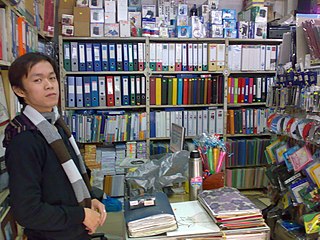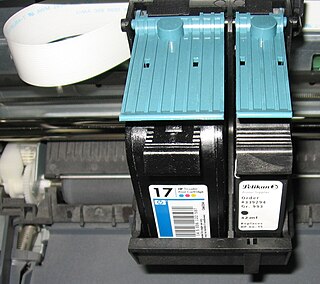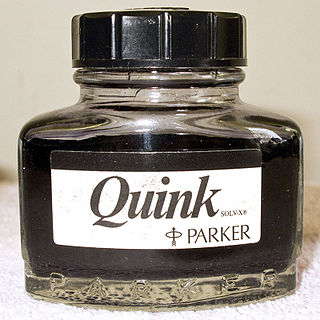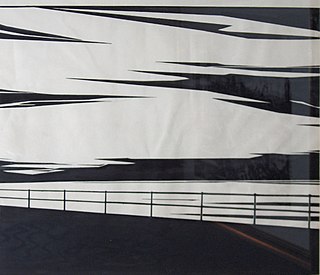
Lithography is a method of printing originally based on the immiscibility of oil and water. The printing is from a stone or a metal plate with a smooth surface. It was invented in 1796 by German author and actor Alois Senefelder as a cheap method of publishing theatrical works. Lithography can be used to print text or artwork onto paper or other suitable material.

A tattoo is a form of body modification where a design is made by inserting ink, dyes and pigments, either indelible or temporary, into the dermis layer of the skin to change the pigment. The art of making tattoos is tattooing.

Screen printing is a printing technique whereby a mesh is used to transfer ink onto a substrate, except in areas made impermeable to the ink by a blocking stencil. A blade or squeegee is moved across the screen to fill the open mesh apertures with ink, and a reverse stroke then causes the screen to touch the substrate momentarily along a line of contact. This causes the ink to wet the substrate and be pulled out of the mesh apertures as the screen springs back after the blade has passed. One color is printed at a time, so several screens can be used to produce a multicoloured image or design.

Printmaking is the process of creating artworks by printing, normally on paper. Printmaking normally covers only the process of creating prints that have an element of originality, rather than just being a photographic reproduction of a painting. Except in the case of monotyping, the process is capable of producing multiples of the same piece, which is called a print. Each print produced is not considered a "copy" but rather is considered an "original". This is because typically each print varies to an extent due to variables intrinsic to the printmaking process, and also because the imagery of a print is typically not simply a reproduction of another work but rather is often a unique image designed from the start to be expressed in a particular printmaking technique. A print may be known as an impression. Printmaking is not chosen only for its ability to produce multiple impressions, but rather for the unique qualities that each of the printmaking processes lends itself to.

Stationery is a mass noun referring to commercially manufactured writing materials, including cut paper, envelopes, writing implements, continuous form paper, and other office supplies. Stationery includes materials to be written on by hand or by equipment such as computer printers.
In printing, under color removal (UCR) is a process of eliminating overlapping yellow, magenta, and cyan that would have added to a dark neutral (black) and replacing them with black ink only, called a Full Black, during the color separation process. Under color removal is used in four-color printing. Black ink used to add details and darkness in shadowed areas is called a Skeletal Black.

A frisket is any material that protects areas of a work from unintended change.
In four-color printing, under color addition (UCA) is a technique for darkening areas of the printed image by adding colored inks. It is meant to achieve the same results as under color removal, but from a different starting position.
Within the CMY color space, a range of colors can be achieved by combining the three primaries. This combination in its turn can be thought of as a hue component and a grey component. If the grey component is replaced by black ink, the same color is being achieved by using two primaries and black. The act of substituting a quantity of black for the grey component is known as "Grey component replacement" (GCR).

Sometimes referred to as scraperboard, but usually called scratchboard in North America and Australia, is a form of direct engraving where the artist scratches off dark ink to reveal a white or colored layer beneath. Scratchboard refers to both a fine-art medium, and an illustrative technique using sharp knives and tools for engraving into a thin layer of white China clay that is coated with dark, often black India ink. There is also foil paper covered with black ink that, when scratched, exposes the shiny surface beneath. Scratchboard can be used to yield highly detailed, precise and evenly textured artwork. Works can be left black and white, or colored.
Degasification is the removal of dissolved gases from liquids, especially water or aqueous solutions. There are numerous possible methods for such removal of gases from liquids.

Permanent makeup is a cosmetic technique which employs tattoos as a means of producing designs that resemble makeup, such as eyelining and other permanent enhancing colors to the skin of the face, lips, and eyelids. It is also used to produce artificial eyebrows, particularly in people who have lost them as a consequence of old age, disease, such as alopecia totalis, chemotherapy, or a genetic disturbance, and to disguise scars and white spots in the skin such as in vitiligo. It is also used to restore or enhance the breast's areola, such as after breast surgery.

An ink cartridge or inkjet cartridge is a component of an inkjet printer that contains the ink that is deposited onto paper during printing.

Richard Rox Anderson, FAAD, is a Boston-based dermatologist and entrepreneur.Today he is the father of two boys.

Tattoo removal has been performed with various tools since the start of tattooing. While tattoos were once considered permanent, it is now possible to remove them with treatments, fully or partially.

Fountain pen ink is a water-based ink intended for use with fountain pens.

CcMmYK, sometimes referred to as CMYKLcLm or CMYKcm, is a six color printing process used in some inkjet printers optimized for photo printing. It complements the more common four color CMYK process, which stands for Cyan, Magenta, Yellow and Key (black), by adding light cyan and light magenta. Individually, light cyan is often abbreviated to Lc or c, and light magenta is represented as Lm or m.

A tattoo cover-up is the act of tattooing over a previously unwanted tattoo with a new tattoo. It is usually seen as being one of two options of removing an unwanted tattoo; the other option being laser removal.

India ink is a simple black or colored ink once widely used for writing and printing and now more commonly used for drawing and outlining, especially when inking comic books and comic strips. India ink is also used in medical applications.















